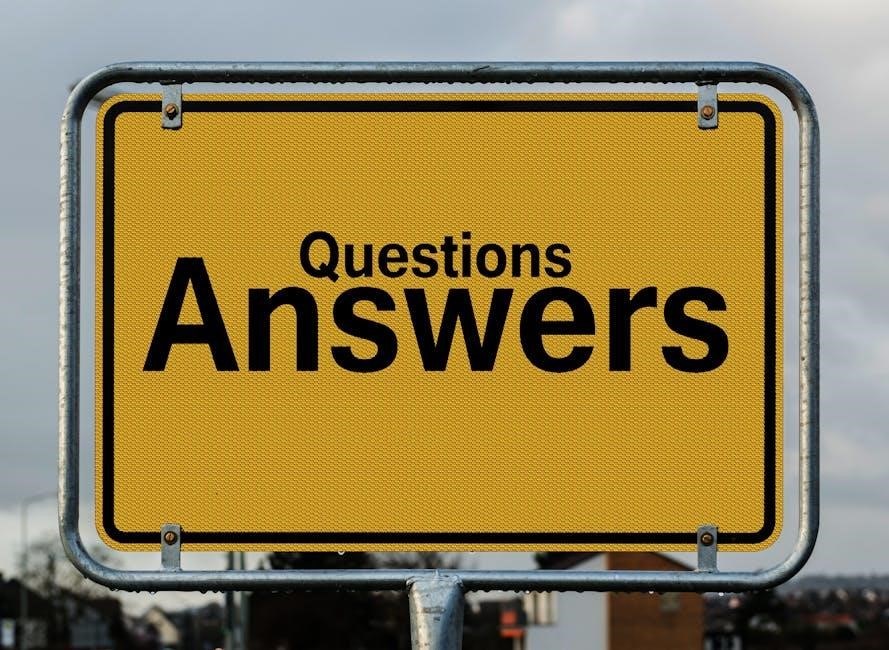This Year 6 Reading Comprehension PDF is designed to enhance reading skills through engaging texts and targeted questions. It includes fiction, non-fiction, and poetry, along with answer booklets for easy assessment. Perfect for schools and home learning, it aligns with curriculum standards to ensure comprehensive skill development.
Overview of the Importance of Reading Comprehension in Year 6
Reading comprehension is a foundational skill for Year 6 students, enabling them to understand and interpret complex texts. It fosters critical thinking, vocabulary expansion, and analytical abilities, essential for academic success. Developing strong comprehension skills helps students excel in various subjects, including history, science, and literature. It also prepares them for standardized tests like SATs and future educational challenges. By improving reading fluency and understanding, students can engage more deeply with texts, enhancing their overall learning experience. Mastering comprehension at this stage builds confidence and lays a strong foundation for upper-level studies, while fostering a lifelong love for reading and learning.
Structure of the Year 6 Reading Comprehension PDF
The Year 6 Reading Comprehension PDF is thoughtfully organized into three distinct reading booklets: fiction, non-fiction, and poetry. Each booklet contains engaging texts followed by comprehension questions tailored to assess understanding and critical thinking. Accompanying answer booklets and mark schemes provide clear solutions and assessment criteria, making it easy for teachers and parents to evaluate progress. The PDF also includes a variety of text types, such as classic literature excerpts, modern stories, and informational articles, ensuring a well-rounded reading experience. This structured format aligns with curriculum standards, offering a comprehensive tool for improving reading skills and preparing students for standardized tests like SATs.
Benefits of Using PDF Resources for Reading Practice
Using PDF resources for Year 6 reading practice offers numerous advantages. They are easily accessible, printable, and can be shared digitally, making them convenient for both teachers and students. PDFs provide a structured format with clear text and questions, ensuring consistency in learning. They are also cost-effective and environmentally friendly, reducing the need for physical materials. Additionally, PDF resources often include answer keys and mark schemes, allowing for self-assessment and immediate feedback. This format supports independent learning and helps students track their progress over time. PDFs are also versatile, suitable for classroom use or home study, and can be easily stored for future reference.

Components of the Year 6 Reading Comprehension Pack
The pack includes fiction, non-fiction, and poetry texts, supported by answer booklets and mark schemes, designed to enhance reading skills and understanding in Year 6 students.
Fiction Reading Booklets
The Fiction Reading Booklets are a key component of the Year 6 Reading Comprehension Pack, offering engaging stories that captivate young learners. These booklets feature a range of texts, from classic tales to modern narratives, designed to spark imagination and curiosity. Each story is followed by carefully crafted comprehension questions that assess understanding, encourage critical thinking, and help students develop their ability to interpret characters, settings, and themes. The booklets are structured to cater to varying reading abilities, ensuring all students can access the content. They also include opportunities for students to practice identifying figurative language, making inferences, and summarizing key plot points. This resource aligns with curriculum standards, providing teachers with a reliable tool to assess progress and prepare students for formal assessments. The PDF format ensures easy access and printing, making it a practical and versatile resource for both classroom and home learning environments.
Non-Fiction Reading Booklets
The Non-Fiction Reading Booklets are designed to enhance students’ understanding of factual texts, a crucial skill for Year 6 learners. These booklets include a variety of engaging topics, such as science, history, and environmental studies, to cater to diverse interests. Each text is accompanied by comprehension questions that focus on identifying main ideas, understanding cause-and-effect relationships, and interpreting factual information. The booklets also encourage critical thinking by asking students to evaluate evidence and make informed conclusions. Aligning with curriculum standards, they provide a structured approach to improving non-fiction reading skills. Additionally, the PDF format allows for easy access and printing, making it an ideal resource for both classroom activities and independent study. These booklets are a valuable tool for helping students master the skills needed for real-world reading tasks.

Poetry and Other Text Types
The Poetry and Other Text Types section introduces Year 6 students to a variety of literary forms, fostering a deeper appreciation for language and structure. Poetry booklets include classic and contemporary pieces, encouraging students to explore themes, imagery, and figurative language. Other text types, such as diaries and letters, provide opportunities to analyze narrative voices and purposes. These diverse texts help students develop a broader understanding of literary devices and their uses. The booklets include comprehension questions that focus on interpreting meaning, identifying tone, and analyzing the author’s intent. This variety enriches students’ reading experiences and enhances their analytical skills, preparing them for more complex texts.
Answer Booklets and Mark Schemes
The Year 6 Reading Comprehension PDF includes detailed Answer Booklets and Mark Schemes to support accurate assessment. These resources provide clear answers to all comprehension questions, ensuring consistency in marking. The mark schemes outline the criteria for awarding marks, helping teachers and parents evaluate student performance effectively. They align with curriculum standards, making it easier to track progress and identify areas for improvement. The answer booklets also serve as valuable learning tools, allowing students to review their work and understand where they can refine their skills. This feature makes the PDF pack a comprehensive and practical resource for both teaching and independent study.
How to Use the Pack Effectively
To maximize the benefits of the Year 6 Reading Comprehension PDF, establish a structured approach. Begin by introducing the fiction, non-fiction, and poetry texts in short, manageable sessions. Encourage students to read independently before answering questions to build confidence. Use the Answer Booklets for self-assessment or teacher-led review sessions. Tailor the pack to individual needs by focusing on weaker areas identified through progress tracking. Rotate text types weekly to maintain variety and engagement. Encourage students to highlight key points in texts and explain their answers aloud. Regularly review mark schemes to understand scoring criteria and provide constructive feedback. This method ensures consistent improvement and mastery of comprehension skills.

Fiction Reading Comprehension
Fiction texts help Year 6 students develop skills in understanding characters, settings, and plot structures. They enhance imaginative thinking and critical analysis, aligning with curriculum standards.
Classic Literature Examples (e.g., “The Railway Children” by E. Nesbit)
Classic literature is essential for Year 6 students, offering rich, engaging stories that enhance comprehension skills. E. Nesbit’s “The Railway Children” is a timeless example, exploring themes of family, kindness, and perseverance. These texts provide opportunities to analyze character development, plot progression, and historical contexts. Students learn to identify moral lessons and connect with universal themes. The PDF includes extracts from such works, paired with questions that guide students in understanding and interpreting classic narratives. These stories not only improve reading fluency but also foster a deeper appreciation for literary heritage. They are ideal for developing critical thinking and cultural awareness in young learners.
Modern Fiction Texts (e.g., “Wonder” by R.J. Palacio)
Modern fiction texts, like R.J. Palacio’s “Wonder,” are vital for Year 6 reading comprehension. These stories often explore contemporary themes such as empathy, diversity, and self-acceptance, resonating with young readers. “Wonder” follows Auggie Pullman, a boy with a rare facial difference, as he navigates friendships and challenges. Such texts help students develop emotional intelligence and critical thinking. The PDF includes extracts from modern novels, accompanied by questions that focus on character analysis, theme identification, and inference skills. These stories also encourage students to reflect on real-world issues, fostering a deeper understanding of different perspectives and experiences. They are engaging and relevant for today’s learners.
Adventure Stories (e.g., “Treasure Island” by R.L. Stevenson)
Adventure stories like “Treasure Island” captivate Year 6 students with thrilling plots and memorable characters. These texts introduce themes of bravery, loyalty, and morality, while fostering a love for reading. The PDF includes excerpts from classic and modern adventure tales, paired with comprehension questions that test students’ ability to infer meaning, analyze characters, and understand plot structures. Adventure stories often feature vivid settings and suspenseful narratives, encouraging students to think critically about motivations and consequences. Such texts also help students develop vocabulary and sentence structure awareness, making them a valuable part of the reading comprehension curriculum. They inspire imaginative thinking and engagement with literature.
Key Comprehension Skills for Fiction Texts
Mastering fiction comprehension involves several key skills, including inference, character analysis, and theme identification. Students learn to read between the lines, understand motivations, and interpret symbolic elements. Summarizing plots and identifying cause-and-effect relationships are also crucial. The PDF provides targeted exercises to enhance these skills, ensuring students can decode complex texts and extract deeper meanings. By focusing on dialogue, setting, and language use, students develop a richer understanding of fictional narratives. These skills are reinforced through structured questions, helping Year 6 pupils build confidence and proficiency in analyzing fiction texts effectively. Regular practice strengthens their ability to engage critically with stories and their elements;

Non-Fiction Reading Comprehension
Non-fiction reading comprehension focuses on understanding factual texts like articles, biographies, and essays, requiring critical thinking and the ability to extract relevant information effectively.
Informational Texts (e.g;, “How to Design the World’s Best Roller Coaster”)
Informational texts are designed to inform or explain a topic, often requiring students to understand complex ideas and technical vocabulary. For Year 6 students, these texts are crucial for improving comprehension skills, as they introduce real-world concepts. Examples like “How to Design the World’s Best Roller Coaster” engage students with practical, hands-on information while challenging them to extract key details; These texts often include cause-and-effect relationships, step-by-step instructions, and specialized terms, helping students develop analytical thinking. By studying such materials, pupils learn to identify main ideas, supporting details, and the author’s purpose, preparing them for more advanced reading in upper-level education.
Comparative Texts (e.g., “Wood v. Steel” by Paul Mason)
Comparative texts are designed to explore similarities and differences between two or more subjects, fostering critical thinking and analytical skills. In “Wood v. Steel”, Paul Mason examines the pros and cons of using wood versus steel in roller coaster construction. Such texts challenge Year 6 students to evaluate information, identify perspectives, and draw conclusions. By comparing and contrasting, students enhance their ability to understand complex arguments and make informed judgments. These texts also encourage pupils to consider multiple viewpoints, strengthening their comprehension and preparing them for more advanced comparative analysis in later education. This skill is essential for evaluating real-world arguments and debates.
Instructional Texts and Their Purpose
Instructional texts are designed to guide readers through a process, providing clear steps or explanations to achieve a specific goal. These texts are essential for Year 6 students to master procedural understanding, whether it’s following a recipe, conducting a science experiment, or assembling a model. Instructional texts often include sequenced instructions, diagrams, and safety tips to ensure clarity. They teach students to identify key details, follow directions accurately, and apply practical skills. By engaging with instructional texts, pupils develop the ability to comprehend and execute complex tasks independently, enhancing their problem-solving and critical thinking abilities. This skill is vital for real-world applications and future learning.
Developing Critical Thinking with Non-Fiction
Non-fiction texts play a crucial role in fostering critical thinking skills among Year 6 students. By engaging with factual material, pupils learn to analyze information, evaluate evidence, and form well-supported opinions. Non-fiction encourages readers to question assumptions, identify bias, and consider multiple perspectives. Activities such as comparing sources, identifying cause-and-effect relationships, and synthesizing information help students develop deeper understanding. These skills are transferable to real-world scenarios, enabling students to make informed decisions and solve problems effectively. Regular practice with non-fiction texts strengthens analytical abilities, preparing students for more complex academic challenges and independent learning in the future.

Poetry and Other Text Types
Poetry introduces students to rhythm, rhyme, and imagery, while other text types like diaries and letters broaden understanding of diverse writing styles, enhancing comprehension skills.
Poetry comprehension is a vital skill for Year 6 students, helping them explore imaginative language and emotional depth. Poems often use rhythm, rhyme, and imagery to convey meaning, requiring readers to interpret figurative language and themes. This section introduces students to the unique challenges of understanding poetry, encouraging them to analyze structure, tone, and literary devices. The PDF provides engaging exercises and questions to guide students in identifying themes, making inferences, and connecting personal experiences to poetic ideas. By practicing with a variety of poems, students build confidence in decoding complex texts and appreciating the beauty of poetic expression.
Understanding Figurative Language in Poems
Figurative language is a key element in poetry that helps convey meaning beyond the literal interpretation of words. Common techniques include similes, metaphors, personification, and imagery. These devices create vivid descriptions, evoke emotions, and explore complex themes. For Year 6 students, understanding figurative language enhances their ability to interpret poems and uncover deeper meanings. The PDF provides exercises that focus on identifying and explaining these literary devices, helping students develop critical thinking and analytical skills. By mastering figurative language, students can better appreciate the richness of poetic texts and improve their overall reading comprehension abilities in a engaging and meaningful way.
Other Text Types (e.g., Diaries, Letters)
Beyond poetry, the Year 6 Reading Comprehension PDF includes extracts from diaries, letters, and other text types to broaden students’ reading experiences. These texts often feature personal perspectives and descriptive language, helping students understand different writing styles. Diaries, for example, provide insights into characters’ thoughts and feelings, while letters offer a formal or informal tone. The PDF includes questions that focus on identifying main ideas, making inferences, and understanding the purpose of the text. Such exercises help students develop a deeper appreciation for diverse writing formats and improve their ability to analyze various text types effectively. These skills align with curriculum standards and prepare students for more complex readings.
Engaging Students with Diverse Texts
Engaging students with diverse texts is a key focus of the Year 6 Reading Comprehension PDF. By incorporating a variety of text types, including fiction, non-fiction, poetry, and more, the resource ensures students encounter different writing styles and perspectives. Interactive activities, such as comprehension questions and critical thinking exercises, encourage active participation. The inclusion of relatable themes and modern texts helps students connect emotionally with the material, fostering a deeper understanding and enthusiasm for reading. This approach not only enhances comprehension skills but also broadens students’ cultural and social awareness. The PDF’s diverse content ensures that all learners are catered to, promoting inclusivity and engagement in the classroom. Regular practice with varied texts builds confidence and independent reading habits, essential for long-term academic success. The structured yet flexible format allows teachers to adapt resources to meet individual student needs, ensuring every child can thrive. By making reading relevant and enjoyable, the PDF inspires a lifelong love of learning.

Assessment and Progress Tracking

The Year 6 Reading Comprehension PDF includes answer booklets, mark schemes, and progress tracking tools to assess student understanding and skill acquisition effectively over time.
The Year 6 Reading Comprehension PDF includes detailed answer booklets and mark schemes, providing clear guidance for assessing student responses. These resources are designed to ensure accurate grading and consistency. Teachers can use the mark schemes to evaluate comprehension skills effectively, while students benefit from clear feedback. The answer booklets cover all texts within the pack, offering model responses and highlighting key points. This feature not only saves time but also helps teachers identify areas where students may need additional support. The structured format ensures fairness and transparency in assessment, making it easier to monitor progress and understanding over time.
Aligning with Curriculum Standards
The Year 6 Reading Comprehension PDF is carefully designed to align with national curriculum standards for reading skills at this level. It covers essential competencies such as understanding fiction, non-fiction, and poetry, ensuring comprehensive coverage of all required text types. The resource incorporates extracts and questions that reflect the depth and breadth of Year 6 expectations, preparing students for formal assessments. By focusing on key areas like inference, deduction, and analysis, the PDF helps students meet curriculum goals effectively. This alignment ensures that teachers can confidently use the material to support both teaching and learning, knowing it addresses all necessary skills and standards.
Using Comprehension Tests for Skill Acquisition
Comprehension tests in the Year 6 Reading Comprehension PDF are designed to reinforce skill acquisition through targeted practice. These tests focus on specific reading strategies, such as identifying main ideas, making inferences, and understanding vocabulary in context. By regularly completing these tests, students develop a deeper understanding of texts and improve their ability to analyze and interpret information. The variety of question types ensures that students practice a range of skills, from literal comprehension to higher-order thinking. Over time, these tests help build confidence and fluency, equipping students with the tools they need to tackle more complex texts independently. Regular testing also highlights areas for further practice, ensuring steady progress in reading abilities. This structured approach makes skill acquisition both effective and measurable.
Tracking Student Progress Over Time
Tracking student progress over time is essential for monitoring growth in reading comprehension skills. The Year 6 Reading Comprehension PDF with answers provides a clear framework for assessing improvements. By regularly reviewing completed exercises and comparing results over time, teachers and parents can identify areas of strength and weakness. The inclusion of answer booklets allows for accurate self-assessment, helping students recognize their own progress. This longitudinal approach enables tailored support, ensuring that each student receives targeted practice to address specific needs. Over time, this systematic tracking fosters confidence and a clear understanding of how skills have developed, guiding future learning strategies effectively.

Resources and Where to Find Them
Year 6 reading comprehension PDFs with answers are widely available on educational websites, government portals, and teacher resource platforms, offering free, accessible materials for learning and exam preparation.
Recommended Websites for Free PDF Downloads
Several websites offer free Year 6 reading comprehension PDFs with answers, including BBC Bitesize, Teachit, and The School Run. These platforms provide high-quality resources aligned with curriculum standards, featuring diverse texts and exercises. BBC Bitesize offers interactive activities and printable worksheets, while Teachit specializes in teacher-created materials. The School Run provides comprehensive practice packs tailored to specific skills. These websites are user-friendly, with filters for year groups and text types, ensuring easy access to suitable materials. They are ideal for both home learning and classroom use, offering a variety of engaging and educational content to support reading development effectively.
Government Publications and Educational Resources
Government publications and educational resources provide reliable and curriculum-aligned reading comprehension materials for Year 6 students. The UK Department for Education (DfE) offers downloadable PDFs, including reading comprehension frameworks and assessment guides. The National Literacy Trust also publishes free resources, such as reading guides and activity sheets, tailored for Key Stage 2. Additionally, the UK Government Publications website hosts educational PDFs designed to support reading skills. These resources are often created by education professionals and align with national curriculum standards, ensuring they are both relevant and effective for improving comprehension skills in Year 6 students.
Using Student Practice Books for Portfolios
Student practice books are valuable tools for creating portfolios that showcase progress in reading comprehension. By incorporating completed PDF worksheets and annotated texts, teachers and students can track improvement over time. Portfolios provide a comprehensive record of a student’s journey, highlighting strengths and areas for development. Regularly updating these portfolios with dated work samples helps identify growth patterns. Additionally, they serve as a resource for parent-teacher conferences and assessments, offering tangible evidence of skill development. Organizing the portfolio with clear sections for fiction, non-fiction, and poetry ensures easy access to specific examples of progress in different text types.
Additional Materials for Enhanced Learning
To enhance Year 6 reading comprehension, additional materials such as interactive worksheets, crossword puzzles, and word searches can be used. Audiobooks and video summaries provide alternative ways for students to engage with texts. Flashcards for vocabulary building and graphic organizers for mapping story structures are also effective. Digital tools like reading apps and online quizzes offer interactive practice. These resources cater to different learning styles, ensuring a well-rounded approach to comprehension. By incorporating these materials, students can deepen their understanding of texts and develop a lifelong love for reading. They also make learning fun and engaging, fostering a positive attitude toward academic success.
Mastery of Year 6 reading comprehension empowers students with essential skills, confidence, and a lifelong love for reading. This structured approach ensures a deep understanding and appreciation of diverse texts, fostering academic and personal growth.
The Year 6 Reading Comprehension PDF with Answers offers numerous benefits, including improved reading skills, enhanced vocabulary, and better understanding of complex texts. It provides structured practice, enabling students to develop critical thinking and analytical abilities. The inclusion of answers allows for self-assessment and immediate feedback, fostering independence and confidence. The diverse range of texts, from fiction to non-fiction, ensures a well-rounded learning experience. Regular use of the resource helps students track their progress and identify areas for improvement. This comprehensive pack aligns with curriculum standards, making it an invaluable tool for teachers and parents aiming to support Year 6 students in achieving reading proficiency.

Encouraging Independent Reading Practice
The Year 6 Reading Comprehension PDF with Answers is designed to promote independent reading practice, allowing students to work at their own pace and explore a variety of texts. By providing clear instructions and self-contained exercises, the resource empowers students to take ownership of their learning. The inclusion of answers enables them to check their understanding immediately, fostering a sense of responsibility and confidence. This independence helps students develop a love for reading while improving their comprehension skills. Regular, self-directed practice also reinforces learning and prepares students for more advanced texts in the future.
Final Tips for Effective Use of the PDF Pack
To maximize the benefits of the Year 6 Reading Comprehension PDF with Answers, encourage consistent practice and variety in text types. Start with shorter passages to build confidence, then gradually introduce longer texts. Use the answer booklets for self-correction, helping students identify areas for improvement. Encourage students to highlight or underline key points in the texts to develop active reading habits. Rotate between fiction, non-fiction, and poetry to keep practice engaging. Discuss challenging questions with peers or teachers to deepen understanding. Set achievable goals and track progress over time. Celebrate small achievements to maintain motivation and foster a growth mindset.
